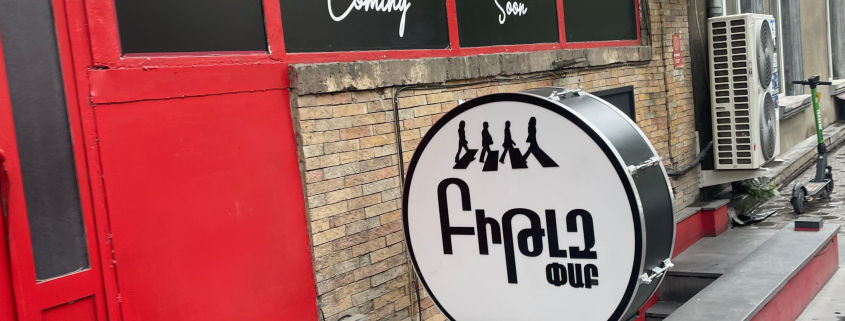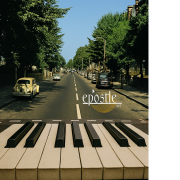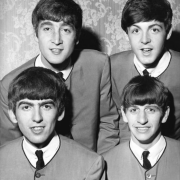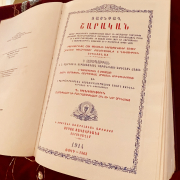Here, There, Everywhere
Roots of Armodoxy: Here, There, Everywhere
Four icons hang on Pushkin Street in the middle of Yerevan. For all the breath-taking, amazing, architecturally groundbreaking edifices from antiquity that we have highlighted, these icons are the only one that are internationally recognized. On the corner of Pushkin St. and an obscure alley way is the sign in Armenian letters, “Beatles Pub,” the photos of the Fab Four, John, Paul, George and Ringo, cover the front windows and a sign that says “coming soon.” No explanation necessary – everyone know, the “soon” is in reference to the pub and not the group.
The Beatles Pub, in many ways, is the best explanation of Armodoxy that we can give. The faith of the Armenian Church – Armenian Orthodoxy – does not exist in a vacuum. Just as Jesus came to the world – the tangible real world – Armenian Orthodoxy has a voice in the real world, the world we live in.
One of the greatest human expressions is music. It is a language that speaks to the soul. This is why all religious traditions incorporate music into their rituals and we in the Armenian Church have a treasure house of hymns, based on eight modalities, that connect human existence to the divine sphere. They speak of the manner in which people have perceived or understood the Divine. The hymns, which we refer to as sharagan, are expressions of our theology.
As people, we naturally search for meaning, and connect dots to things greater than ourselves. Music gives us a forum to do so, whether sacred music or pop song. For instance, when Paul McCartney sings “Mother Mary comes to me,” he is speaking of his own mother, whose name was Mary, but millions who have heard Let it Be made a connection to the blessed virgin. When John Lennon sings, “Imagine there’s no heaven,” it forces us to think about the divisions that are caused because of belief systems. Elanor Rigby’s priest, Father McKenzie writes words to a sermon that no one hears the Inner Light asks us see without looking. Most importantly, we all can buy into “All you need is Love” and “Give Peace a Chance.”
When the Beatles “invaded” the world in the early 1960’s, life changed. The Beatles’ influence on pop culture is undeniable, but their influence is much farther reaching and affects just about every arena primarily because their music – melodies and words – have been absorbed by such a diverse population for the last 60+ years. As a young boy, I remember my grandmother humming the tune, “Yesterday” as she went about daily chores. She was a genocide survivor and was in her 60’s when the Beatles were a hit. I was never sure what about the song attracted her ear. Could it have been that yesterday, all her troubles were far away? or was it simply the eloquent music that had already touched millions deep in the soul? On the other end of the age spectrum, my niece, in her 20s, who upon moving to New York paid homage to John Lennon by visiting the Strawberry Fields Memorial. The span of years between my grandmother and my niece is over 100 years; the Beatles touched across generations, how can their influence be discounted?
Armodoxy is the recognition that our faith exists in a world that is living and breathing. Because it is living, it is evolving. The alternative to life is death, in which case matter does not evolve but decays. Armodoxy is about pushing ourselves to understand our faith within the context of life. When Jesus offered parables using a grain of wheat or the mustard seed or grapes and the vineyard, he was speaking to the people in a language which they all understood. The people of the time lived in an agrarian society; they were people of the land. They knew what a mustard seed was, much like a child of today knows what an app is.
Armodoxy is the realistic admission that culture and the life-forces around us, impact and influence us. It is the recognition that Christianity evolved in a pocket of the world, among a group of people, inside of the Armenian Church, and those people survived and thrived against the odds. Armodoxy is the secret formula, so to speak, of how faith and life intertwine and give us meaning. It is the recognition that God did not create us as robots but gave us the gift of thought to interact, to discuss, to arrive at the point of understanding and harmony with our fellow human being. Coupled with our prayer life, we share the unchanging Truth of God that has reached us today. We are the custodians of that Tradition for the time that we are allotted in this world.
The Beatles pub was opening soon. Unfortunately, we were unable to see it in action, but a few weeks after we left, it was Ringo Starr’s birthday (7/7) and they celebrated there, and accented his motto phrase, Peace and Love – khaghootiun yev ser – which is the bottom line, whether sung or said, in English or Armenian, classical or contemporary.
From the Armenian Book of Hours we pray, “Peace and life, our Lord and Savior, the Only Begotten Son of God, give us Your peace, that you grant to your apostles by breathing into them Your life-giving and all powerful Holy Spirit, so that having found our peace from all worldly commotions we may become a temple and a habitation of your grace, and may give you thanks and glorify you together with the Father and Holy Spirit, now and forever. Amen.

 2023 Fr. Vazken Movsesian
2023 Fr. Vazken Movsesian 2025 Epostle
2025 Epostle








Leave a Reply
Want to join the discussion?Feel free to contribute!